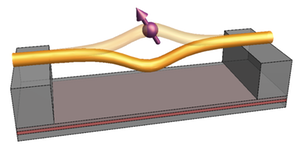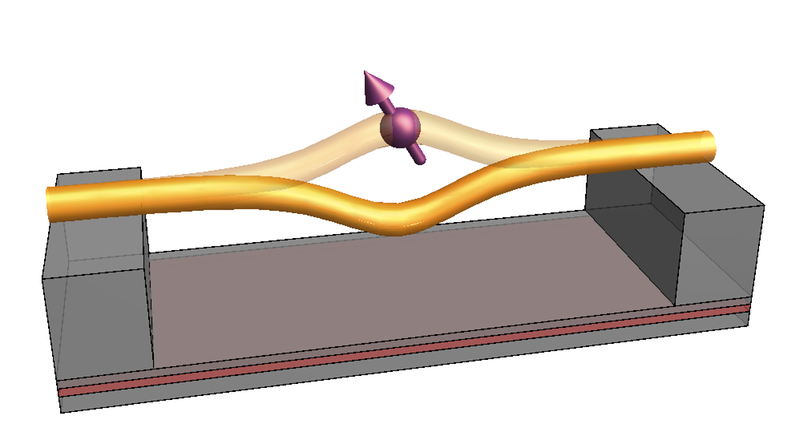Electron Spin Influences Nanotube Motion
The spin of an electron often occupies a reality all its own, with little bearing on the electron’s overall motion or the motion of nearby atoms. But theoretical work reported in Physical Review Letters demonstrates that the spin of a single electron trapped on a carbon nanotube may influence—and be influenced by—the vibrations of the nanotube. The researchers behind the work foresee this spin-mechanical combination having a role in nanoscale mass sensors or in information processing elements of a quantum computer.
Electron spin sometimes makes its presence known in subtle ways. A single energy level in an atom can become two closely spaced levels because of so-called spin-orbit coupling. In this effect, the motion of the electron around the nucleus creates an effective magnetic field that causes spin-up electrons to have a slightly different energy from spin-down electrons. A similar sort of spin-orbit coupling was recently discovered in carbon nanotubes [1]. The delocalized electrons, those not associated with specific atoms, follow circular orbits around the tube circumference. As in an atom, this motion causes one orientation of the electron spin to have lower energy than the opposite orientation.
This relationship between the electron spin and the cylindrical geometry of a nanotube means that motion of the tube could alter the spin, and vice versa. András Pályi of Eötvös University in Budapest and his colleagues have now proposed an experiment to demonstrate this connection. The proposal is based on recent work examining the relationship between nanotube motion and electric current [2].
In their model, the team imagines a carbon nanotube suspended between two leads about a half micron apart, with a single electron trapped on this “tightrope.” An externally applied magnetic field pointing along the nanotube axis splits the ground state of the electron into two energy levels, corresponding to the electron spin being parallel and antiparallel to the magnetic field.
As in earlier work, vibrations in the nanotube can be excited by radio waves tuned to one of the resonant frequencies. The changes in the shape of the nanotube alter the orbital path of the trapped electron, and because of the strong spin-orbit coupling, the electron’s spin can switch direction [3]. In order to maximize the effect on the spin, the theorists found that the magnetic field strength must be set so that the energy difference between the two spin states matches the energy of the nanotube vibration.
Pályi and his colleagues found that the system mimics the well-studied case of an atom in an optical cavity, where the atom can only emit or absorb light for which an integer number of half-wavelengths matches the cavity’s length. Similarly, in the sound wave (or phonon) cavity of the stretched nanotube, transitions between the two spin states are driven by nanotube vibrations. And the influence goes both ways, as numerical calculations showed that the coupling to a single electron spin shifts the frequency at which the nanotube vibrates.
The team says that adding such a spin-dependence could improve the sensitivity of nanotube-based sensors that can already measure the mass of a handful of atoms. In quantum computing, the oscillations of the nanotube could be used to flip the value of a spin qubit or process it in some way. Since the nanotube motion can be driven by simple radio waves from a small antenna, this qubit control might be less challenging than other techniques that rely on rapidly varying magnetic fields, Pályi says.
“This is a promising hybrid system, and experiments are making rapid progress, placing novel proposals like this in high demand,” says Steven Bennett from Harvard University. One challenge is measuring the vibrations in the nanotube, says Gary Steele from the Technical University of Delft in the Netherlands. Typically this tiny motion has been observed using currents through the nanotube, but the goal here is to keep electrons in place on the nanotube. Developing external detectors of nanotube motion is “a very challenging task,” Steele says, but one that he and others are working on right now.
–Michael Schirber
Michael Schirber is a Corresponding Editor for Physics Magazine based in Lyon, France.
References
- F. Kuemmeth, S. Ilani, D. C. Ralph, and P. L. McEuen, “Coupling of Spin and Orbital Motion of Electrons in Carbon Nanotubes,” Nature 452, 448 (2008)
- G. A. Steele, A. K. Huttel, B. Witkamp, M. Poot, H. B. Meerwaldt, L. P. Kouwenhoven, and H. S. J. van der Zant, “Strong Coupling Between Single-Electron Tunneling and Nanomechanical Motion,” Science 325, 1103 (2009)
- D. V. Bulaev, B. Trauzettel, and D. Loss, “Spin-Orbit Interaction and Anomalous Spin Relaxation in Carbon Nanotube Quantum Dots,” Phys. Rev. B 77, 235301 (2008)





